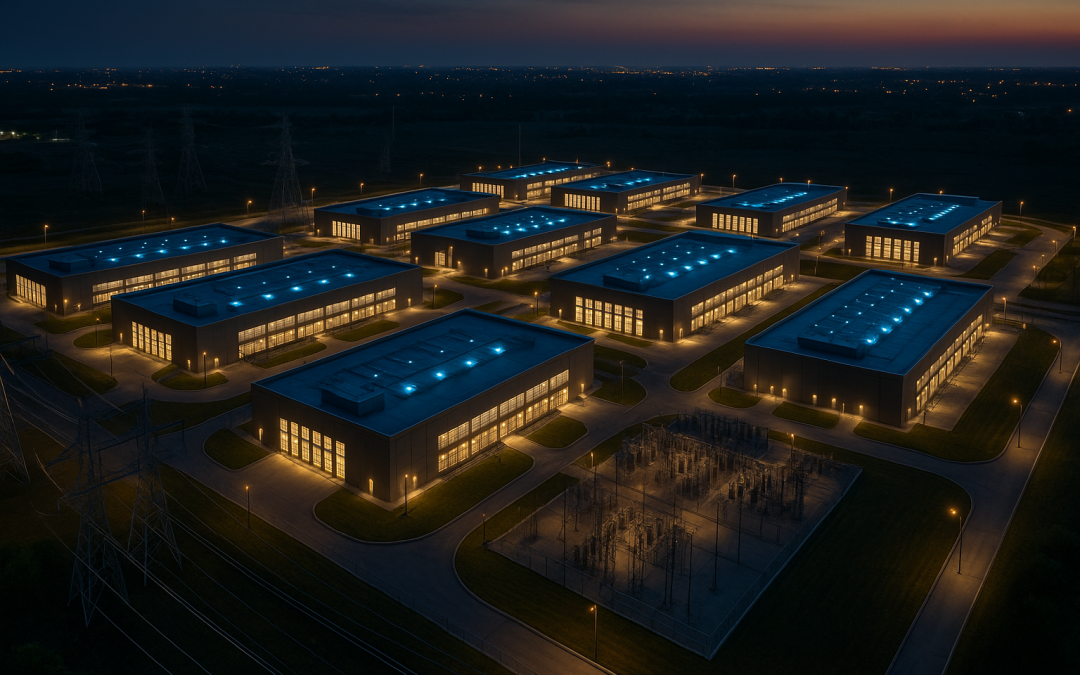Over the last decade, “the cloud” has become synonymous with innovation and efficiency. Organizations of every size have migrated from private infrastructure to hyperscale platforms like AWS, Azure, and Google Cloud in search of scalability, simplicity, and savings.
But beneath the abstraction lies a growing paradox: as cloud computing scales upward, it is concentrating risk. The same efficiencies that make the cloud so powerful are also making it fragile.
Cloud Growth and the Power Demand Dilemma
The global cloud footprint now consumes an astonishing amount of electricity. U.S. data centers alone used roughly 176 terawatt-hours (TWh) in 2023 — around 4.4% of total U.S. power use, according to the Department of Energy. Analysts at Goldman Sachs project that worldwide data center power demand will increase by as much as 165% by 2030, driven heavily by AI workloads and hyperscale expansion.
This growth isn’t geographically balanced. A handful of regions — Northern Virginia, Oregon, Texas, and the Midwest — host the bulk of hyperscale facilities. In Virginia, data centers already account for over 25% of the state’s electricity consumption, pushing utilities to prioritize corporate power contracts while local residents face rising rates.
The “cloud” may seem weightless, but its gravitational pull on the power grid is immense. And as energy availability tightens, the infrastructure that hosts your applications becomes a political and logistical dependency, not just a technical one. Couple this with the political will of an all-renewable energy supply and we have a narrowing ramp towards a collapse of energy availability and skyrocketing energy prices.
A Lesson from the AWS East Coast Outage
On October 20, 2025, Amazon Web Services’ us-east-1 region suffered a widespread outage that disrupted hundreds of major platforms. A single internal DNS configuration error in AWS’s DynamoDB service cascaded across dependent systems — taking down apps, IoT devices, and online services across the globe.
The event was not caused by weather, cyberattack, or physical damage. It was a simple software fault amplified by extreme centralization. Because so much of the world’s compute depends on one region, the outage revealed how brittle and dependant the global web has become.
AWS’s “multi-AZ” redundancy couldn’t help, because Availability Zones in a region share the same regional control plane. When the regional glue failed, all the redundant copies failed with it.
The lesson is clear: multi-AZ isn’t multi-provider, and one region isn’t the internet.
The Hidden Economics of Centralization
For years, cloud economics seemed unbeatable. Renting infrastructure was cheaper than owning it, especially when accounting for staffing and scalability. But those calculations are shifting.
Cloud providers now operate as de facto utilities — securing private energy contracts, often next to nuclear or hydro plants, while customers indirectly subsidize that cost through fluctuating pricing models. The growing demand for AI and high-performance computing means competition for energy is fierce, and the cost of power now quietly shapes your cloud bill.
True resilience, meanwhile, is no longer cheap. Building redundant, cross-region or multi-cloud systems adds substantial complexity and cost. The efficiency that centralized clouds deliver is purchased at the expense of independence — both technical and economic.
Distributed Ownership: The Case for Local Control
Owning infrastructure — even partially — may seem retrograde in an era of infinite elasticity, but it’s becoming a pragmatic hedge. Regional and independent data centers, municipal facilities, and smaller ISPs offer what hyperscale can’t:
- Different grid dependencies
- Local accountability
- Reduced incident impact radius during regional failures
Diversification isn’t just an old buzzword, but resilience. By distributing workloads between hyperscale and regional providers, businesses can insulate themselves from both technical and geopolitical shockwaves.
Furthermore, local infrastructure spending has a multiplier effect: it keeps capital, jobs, and skills within the community rather than channeling them into global hyperscaler ecosystems that prioritize scale over stability.
Building Smarter Cloud Strategies
Resilience in 2025 isn’t just about uptime, but about sovereignty over where and how your workloads live. The five-9’s standard most providers boast about is primarily for power and connectivity. The uptime clauses of contracts does not cover outages like the one experienced earlier this month.
To mitigate concentration risk:
- Use hyperscale cloud for elasticity, not dependence. Keep critical control planes, authentication, and backups elsewhere.
- Architect cross-provider recovery paths. At least one must function independently of your main cloud provider.
- Evaluate the power geography of your infrastructure. Know which grids and utilities ultimately support your compute.
- Budget for resilience. Treat failover capability as a line item, not an afterthought.
The cheapest compute might not be the smartest compute if it fails when everything depends on it.
Conclusion: The Future is Federated
Centralized cloud infrastructure has brought incredible innovation, but at the cost of systemic risk. The AWS outage showed how fragile a globally dependent ecosystem can be, while power demand data shows just how physically grounded the “cloud” really is.
The path forward isn’t anti-cloud. It’s post-centralization. A future where hyperscale providers coexist with local and regional operators, where workloads are diversified, and where resilience comes from distribution, not concentration.
In short: don’t just rent someone else’s computer. Own your resilience.

